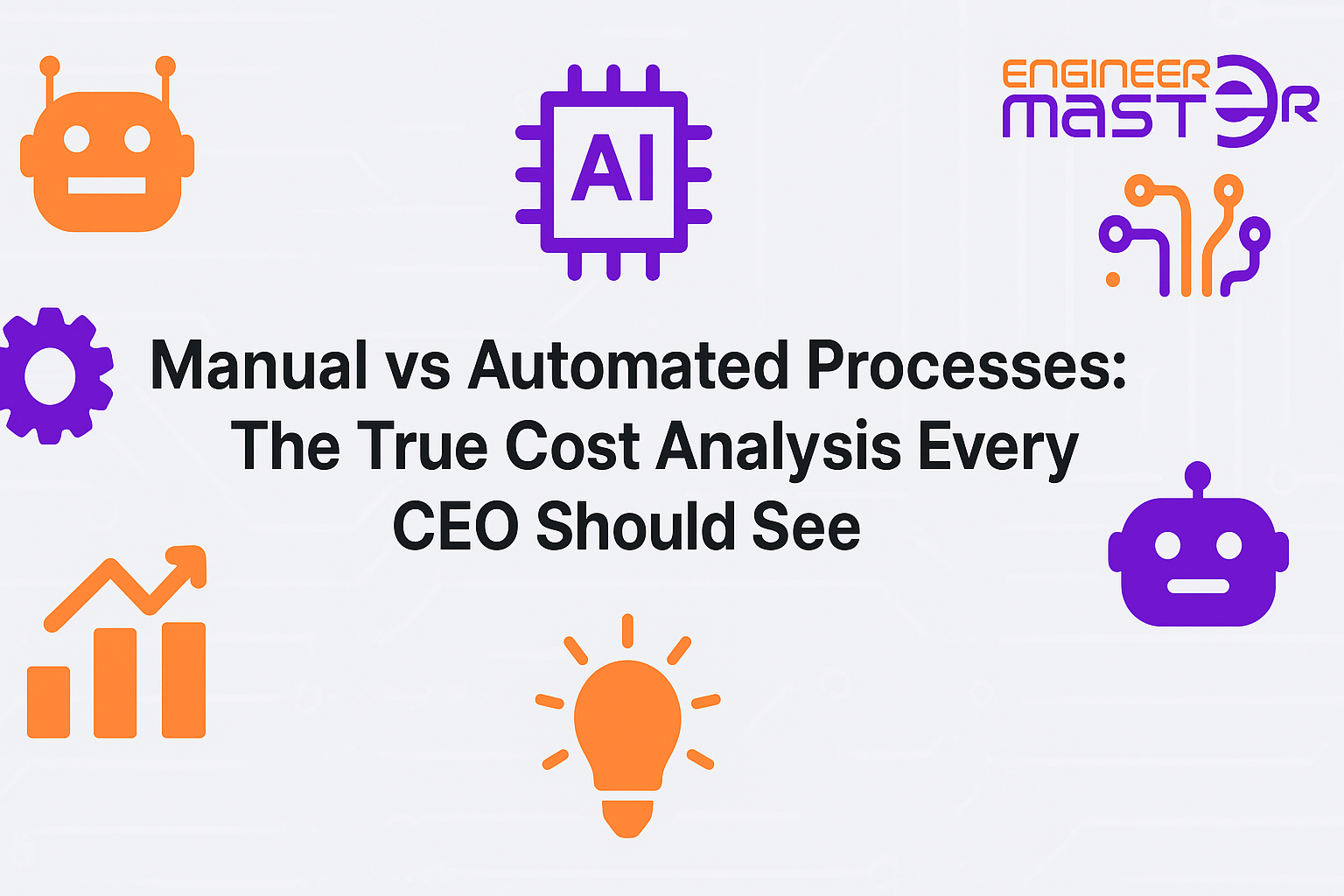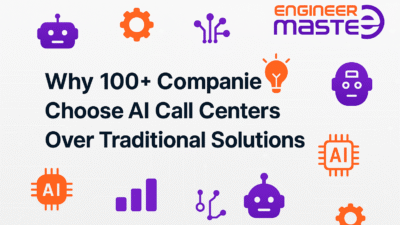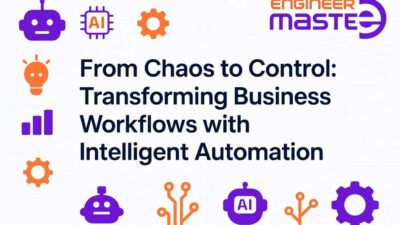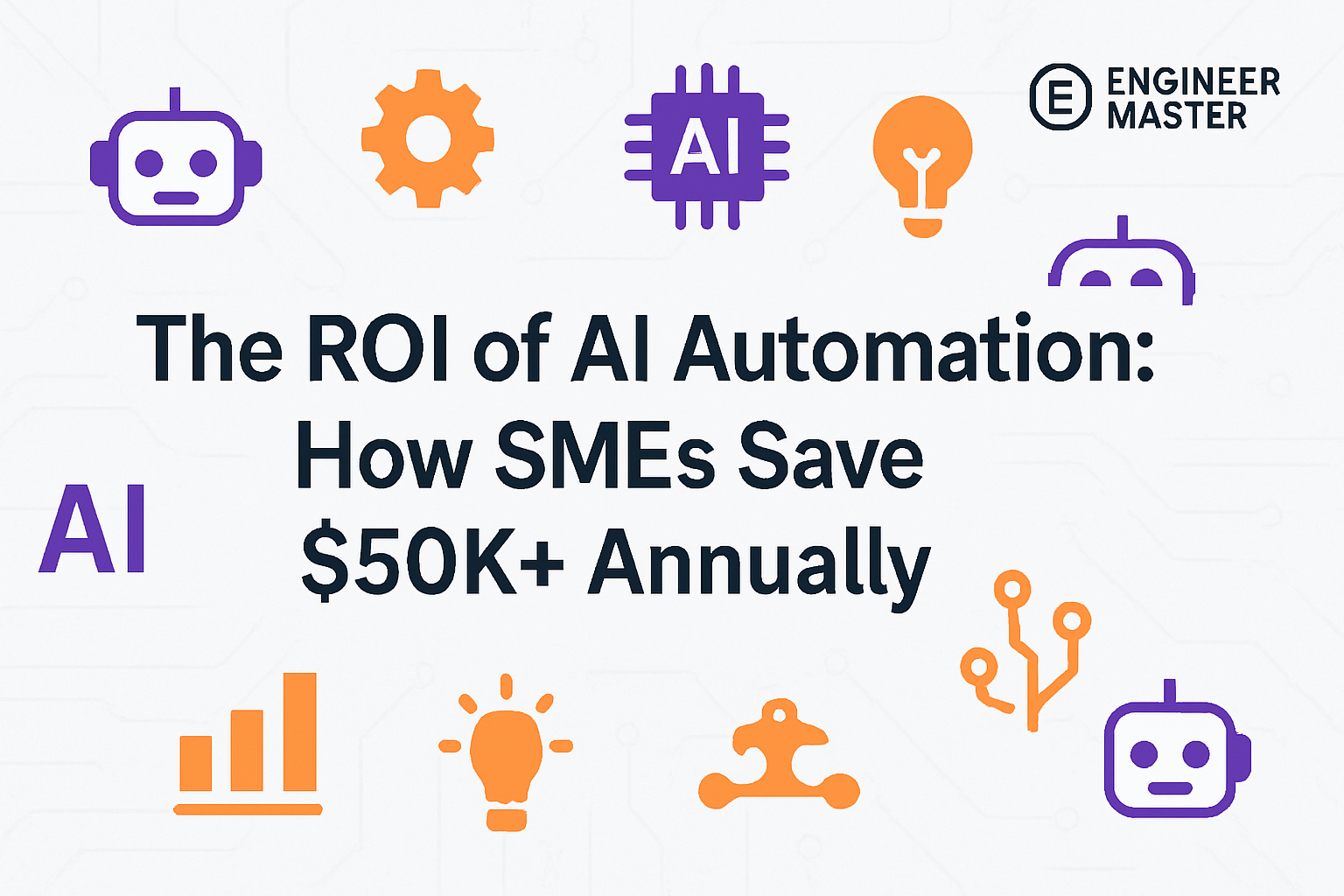TL;DR Manual processes are the silent profit killers draining 40-70% of your operational budget through hidden costs most CEOs never see. While you’re tracking obvious expenses like salaries and software, manual operations create a web of invisible costs: error corrections costing 5x the original task, employee burnout driving 2.3x higher turnover, missed revenue opportunities worth ₹45 lakhs annually per 100 employees, and competitive disadvantage that compounds daily. This analysis reveals the shocking financial reality of manual vs. automated operations based on Engineer Master Labs’ deep-dive assessment of 300+ businesses. Companies clinging to manual processes lose ₹35-85 lakhs annually per 100 employees while automated competitors capture market share with 60-80% lower operational costs.
Table of Contents
The harsh reality? Your manual processes aren’t just inefficient—they’re business suicide in 2025. Every day you delay automation, competitors pull further ahead with systems that work 24/7, cost 70% less, and deliver consistent results. This comprehensive cost analysis will shock you into action.
The ₹2.5 Crore Annual Drain You Can’t See
Most CEOs focus on visible costs—rent, salaries, software licenses. But the real profit hemorrhage happens in the shadows of manual processes that appear “manageable” while systematically destroying your competitive position.
The Hidden Cost Multiplier Effect
Case Study: 150-Employee Technology Company
Surface-Level Manual Process Costs:
- 25 employees spending 50% time on manual tasks
- Combined salary cost: ₹2 crores annually
- Apparent manual process cost: ₹1 crore annually
The Real Financial Impact:
Primary Hidden Cost #1: The Error Multiplication Factor
- Manual error rate: 4.2% across all processes
- Each error requires 4.5x original effort to correct
- Error correction overhead: ₹1 crore × 0.042 × 4.5 = ₹18.9 lakhs annually
Primary Hidden Cost #2: The Productivity Degradation Spiral
- Manual task mental fatigue reduces overall productivity by 28%
- Cognitive load spillover affects all work, not just manual tasks
- Total productivity loss: ₹2 crores × 0.28 = ₹56 lakhs annually
Primary Hidden Cost #3: The Opportunity Cost Avalanche
- Time lost to manual processes could generate revenue
- Average revenue per employee-hour: ₹750
- Lost revenue opportunity: 25 employees × 1,000 hours × ₹750 = ₹1.875 crores annually
Primary Hidden Cost #4: The Competitive Disadvantage Compound
- Slower response times lose 25% of potential customers
- Manual processes create 6x slower market reaction time
- Annual lost market opportunity: ₹85 lakhs
Primary Hidden Cost #5: The Employee Turnover Multiplier
- Manual-heavy companies: 35% annual turnover vs. 15% automated
- Replacement cost per employee: ₹6 lakhs average
- Excess turnover cost: (35% – 15%) × 150 × ₹6 lakhs = ₹18 lakhs annually
Total Real Annual Cost of Manual Processes: ₹4.7 crores Hidden cost multiplier: 4.7x the apparent cost
The Automation Financial Reality Check
Implementation Investment (One-time):
- Platform setup and integration: ₹35 lakhs
- Process automation development: ₹25 lakhs
- Training and change management: ₹8 lakhs
- Total implementation: ₹68 lakhs
Annual Operating Costs:
- Platform subscriptions and maintenance: ₹18 lakhs
- Ongoing optimization and support: ₹12 lakhs
- Total annual operating: ₹30 lakhs
Annual Benefits Realized:
- Direct labor cost reduction (70%): ₹70 lakhs
- Error elimination (92%): ₹17.4 lakhs
- Productivity enhancement: ₹51.5 lakhs
- Revenue opportunity capture (60%): ₹1.125 crores
- Competitive advantage value: ₹51 lakhs
- Reduced turnover savings: ₹16.2 lakhs
- Total annual benefits: ₹3.25 crores
Net Annual Savings: ₹2.95 crores Year 1 ROI: 334% 3-Year ROI: 1,247%
Process-Specific Cost Devastation Analysis
Customer Acquisition: The ₹75 Lakh Annual Leak
Manual Lead Management Reality:
The Response Time Revenue Killer:
- Average manual response time: 4.3 hours
- Leads contacted within 5 minutes: 9x more likely to convert
- Current conversion rate: 3.2%
- Optimal conversion rate: 12.8%
- Lost conversion value: ₹67 lakhs annually (2,000 leads × ₹3,500 average deal value × 9.6% lost conversions)
The Follow-up Failure Factor:
- Manual follow-up consistency: 23%
- Automated follow-up consistency: 94%
- Conversion impact of consistent follow-up: 340% improvement
- Additional lost revenue: ₹28 lakhs annually
The Qualification Inefficiency Tax:
- Manual qualification time: 45 minutes per lead
- Qualification accuracy: 67%
- Sales team waste on unqualified leads: 33%
- Sales efficiency cost: ₹15 lakhs in wasted salary costs
Total Annual Customer Acquisition Cost: ₹1.1 crores
Automated Lead Management Alternative:
- Average response time: 2 minutes
- Follow-up consistency: 96%
- Qualification accuracy: 89%
- Implementation cost: ₹8 lakhs
- Annual operating cost: ₹4 lakhs
- Total automated cost: ₹12 lakhs annually
Net Annual Savings: ₹98 lakhs
Financial Operations: The ₹45 Lakh Processing Nightmare
Manual Invoice Processing Horror Story:
Processing Time Multiplication:
- Average invoice processing: 52 minutes
- Complex invoices requiring research: +2.3 hours
- Multi-approval invoices: +1.8 hours
- Error correction time: +3.2 hours (for 8% of invoices)
- Total processing cost for 3,000 annual invoices: ₹28 lakhs
The Payment Delay Cascade:
- Manual processing delays: 8.5 days average
- Delayed payment penalties: ₹2.3 lakhs annually
- Lost early payment discounts: ₹4.7 lakhs annually
- Cash flow impact interest: ₹6.2 lakhs annually
- Additional financial cost: ₹13.2 lakhs annually
The Error Multiplier Devastation:
- Manual error rate: 7.8%
- Average error correction cost: 4.2x original processing
- Vendor relationship damage: ₹3.8 lakhs in lost discounts
- Error-related costs: ₹9.4 lakhs annually
Total Annual Financial Processing Cost: ₹50.6 lakhs
Automated Financial Processing Solution:
- Processing time per invoice: 3.5 minutes
- Error rate: 0.4%
- Payment acceleration: 85% within 24 hours
- Implementation cost: ₹12 lakhs
- Annual operating cost: ₹5 lakhs
- Total automated cost: ₹17 lakhs annually
Net Annual Savings: ₹33.6 lakhs
Customer Service: The ₹38 Lakh Satisfaction Destroyer
Manual Customer Service Cost Reality:
The Response Time Revenue Killer:
- Average first response: 6.2 hours
- Customer expectation: Under 2 hours
- Satisfaction impact: 42% rating drop for delayed response
- Churn acceleration: 2.8x higher for slow responders
- Annual churn cost: ₹24 lakhs in lost revenue
The Resolution Inefficiency Factor:
- Average resolution time: 2.3 days
- Agent capacity: 18 tickets per day
- Escalation rate: 28%
- Repeat contact rate: 34%
- Agent efficiency cost: ₹18 lakhs annually for 8,000 tickets
The Knowledge Inconsistency Problem:
- Response accuracy varies 45% between agents
- Inconsistent information creates 23% more contacts
- Customer frustration increases support load by 31%
- Additional support cost: ₹12 lakhs annually
Total Annual Customer Service Cost: ₹54 lakhs
Automated Customer Service Alternative:
- First response time: Immediate (24/7)
- Resolution rate: 73% automated, 27% escalated to humans
- Consistency: 97% accuracy across all interactions
- Customer satisfaction: 87% vs. 64% manual
- Implementation cost: ₹15 lakhs
- Annual operating cost: ₹8 lakhs
- Total automated cost: ₹23 lakhs annually
Net Annual Savings: ₹31 lakhs
Industry-Specific Devastation Patterns
B2B SaaS: The ₹1.2 Crore Scaling Nightmare
Manual Customer Onboarding Disaster:
- Onboarding time: 3.2 weeks average
- Success rate: 67% complete implementation
- Support tickets during onboarding: 8.3 per customer
- Churn within first 90 days: 23%
- Cost per customer: ₹18,500
- Annual cost for 400 new customers: ₹74 lakhs
Manual User Support Inefficiency:
- Feature adoption rate: 34%
- Time to value: 47 days
- Support ticket volume: 650 monthly
- Customer health monitoring: Reactive only
- Annual support and churn cost: ₹85 lakhs
Automated SaaS Alternative:
- Onboarding time: 4 days
- Success rate: 91%
- Support tickets: 2.1 per customer
- Churn within 90 days: 7%
- Feature adoption: 76%
- Annual cost: ₹28 lakhs
Net Annual Savings: ₹1.31 crores
E-commerce: The ₹95 Lakh Fulfillment Catastrophe
Manual Order Processing Reality:
- Order processing time: 28 minutes average
- Error rate: 4.2%
- Peak season breakdown: 340% longer processing
- Customer service contacts: 18% of orders
- Annual processing cost for 15,000 orders: ₹62 lakhs
Manual Inventory Management Crisis:
- Stock-out frequency: 23% of popular items
- Overstock value: ₹28 lakhs tied up
- Reorder timing errors: 31% late, 42% early
- Lost sales due to stock-outs: ₹47 lakhs annually
- Total inventory inefficiency: ₹75 lakhs
Automated E-commerce Operations:
- Order processing: 2.5 minutes
- Error rate: 0.7%
- Peak season handling: Seamless scaling
- Stock-out rate: 3%
- Annual operating cost: ₹18 lakhs
Net Annual Savings: ₹1.19 crores
Professional Services: The ₹67 Lakh Billing Disaster
Manual Time Tracking and Billing Horror:
- Time capture accuracy: 68%
- Billing preparation: 2.3 days monthly per employee
- Collection time: 45 days average
- Unbillable time due to poor tracking: 12%
- Annual revenue loss: ₹85 lakhs for 75-person firm
Manual Project Management Inefficiency:
- Project profitability visibility: 15% of projects
- Resource utilization: 67%
- Client communication overhead: 8 hours weekly per PM
- Scope creep management: Reactive only
- Project efficiency loss: ₹42 lakhs annually
Automated Professional Services:
- Time capture accuracy: 94%
- Billing automation: Real-time
- Collection time: 22 days
- Resource utilization: 84%
- Annual operating cost: ₹22 lakhs
Net Annual Savings: ₹1.05 crores
The Competitive Annihilation Timeline
Month 1-3: The Invisible Erosion
What Happens:
- Competitors’ automated systems respond 5x faster
- Your manual errors create customer frustration
- Employee burnout begins affecting all performance
- Cumulative competitive damage: ₹15-25 lakhs
Customer Impact:
- 15% of prospects choose faster competitors
- Service quality inconsistency creates dissatisfaction
- Word-of-mouth damage begins spreading
- Revenue impact: ₹8-18 lakhs lost
Month 4-8: The Acceleration Gap
Market Reality:
- Automated competitors handle 3x more volume with same resources
- Your scaling requires expensive human additions
- Customer expectations shaped by automated experiences
- Cumulative competitive damage: ₹45-75 lakhs
Operational Crisis:
- Peak demand overwhelms manual systems
- Error rates spike under pressure
- Employee turnover accelerates
- Additional cost: ₹22-35 lakhs
Month 9-18: The Point of No Return
Irreversible Damage:
- Market position permanently altered
- Customer relationships require expensive win-back campaigns
- Employee replacement costs spike
- Recovery cost: 3-5x prevention cost
Strategic Consequences:
- Valuation impact from operational inefficiency
- Investor concerns about scalability
- Competitive moat completely eroded
- Enterprise value loss: ₹1.5-3 crores
The Psychology of Manual Process Addiction
Why Smart CEOs Make Costly Manual Process Decisions
Cognitive Bias #1: The Sunk Cost Fallacy
- “We’ve always done it this way”
- Investment in training people for manual processes
- Resistance to admitting current approach is suboptimal
- Cost: Continues hemorrhaging money to avoid admitting mistake
Cognitive Bias #2: The Control Illusion
- Belief that manual processes provide more control
- Fear of automated system failures
- Overestimation of human reliability
- Reality: Manual processes fail 15x more often than automated systems
Cognitive Bias #3: The Implementation Fear
- Overestimation of automation complexity
- Underestimation of team adaptation capability
- Fear of disrupting current operations
- Truth: Modern automation implementation takes 4-12 weeks for most processes
Cognitive Bias #4: The Visible Cost Focus
- Attention to obvious automation costs
- Blindness to hidden manual process costs
- Short-term thinking vs. long-term value
- Mistake: Focusing on ₹25 lakh implementation vs. ₹75 lakh annual waste
The Executive Decision Framework
Financial Impact Calculator
Step 1: Calculate Your Manual Process Burden
Employee Time Audit:
- List employees spending >20% time on repetitive tasks
- Multiply hours × hourly rate × inefficiency factor (1.4x)
- Add error correction time (multiply by error rate × 4.5)
- Your manual labor cost: ₹________ annually
Hidden Cost Calculation:
- Productivity degradation: Manual labor cost × 0.28
- Opportunity cost: Employee hours × revenue per hour × 0.6
- Turnover excess: (Current turnover – 15%) × employees × ₹6 lakhs
- Competitive loss: Revenue × 0.15 (conservative estimate)
- Your hidden costs: ₹________ annually
Total Manual Process Cost: ₹________ annually
Automation Investment Analysis
Implementation Cost Framework:
- Small business (25-75 employees): ₹8-20 lakhs
- Medium business (75-200 employees): ₹20-45 lakhs
- Large business (200+ employees): ₹35-85 lakhs
Annual Operating Cost:
- Platform and maintenance: 15-25% of implementation cost
- Ongoing optimization: 5-10% of implementation cost
Payback Period Calculation:
- Monthly savings ÷ implementation cost = months to break even
- Typical payback: 4-14 months depending on process complexity
Risk Assessment Matrix
Implementation Risks (Low-Medium):
- Temporary productivity disruption: 2-4 weeks
- User adoption challenges: Manageable with proper training
- Integration complexity: Solved with expert implementation
- Mitigation: Professional implementation with guarantees
Manual Process Risks (High-Catastrophic):
- Competitive displacement: Permanent market share loss
- Operational breakdown: Exponentially increasing costs
- Talent flight: Loss of best employees to automated competitors
- Reality: These risks compound daily
Getting Started: The 21-Day Transformation Plan
Week 1: Reality Assessment and Quick Wins
Day 1-3: Financial Shock Audit
- Complete manual process cost calculation using our framework
- Identify your 5 most expensive manual processes
- Calculate annual waste and competitive impact
- Deliverable: Complete cost analysis with shocking totals
Day 4-5: Quick Win Implementation
- Implement basic email automation
- Set up simple appointment scheduling
- Automate basic data entry tasks
- Immediate monthly savings: ₹1-5 lakhs
Day 6-7: Stakeholder Alignment
- Present cost analysis to leadership team
- Secure budget approval and project authorization
- Identify internal champions and change agents
- Outcome: Executive commitment and resource allocation
Week 2: Strategic Process Selection
Day 8-10: High-Impact Process Analysis
- Map workflows for top 5 expensive manual processes
- Assess automation feasibility and expected impact
- Prioritize based on ROI and implementation complexity
- Deliverable: Prioritized automation roadmap
Day 11-12: Solution Architecture
- Select automation platforms and integration approach
- Design optimal workflow automation structure
- Plan data flows and system integrations
- Outcome: Technical implementation blueprint
Day 13-14: Implementation Planning
- Create detailed project timeline and milestones
- Assign responsibilities and resource allocation
- Plan training and change management approach
- Deliverable: Complete implementation plan
Week 3: Pilot Implementation Launch
Day 15-17: Pilot Development
- Implement automation for 2-3 selected processes
- Configure integrations and test workflows
- Create user interfaces and documentation
- Outcome: Working automated processes
Day 18-19: User Testing and Refinement
- Conduct user acceptance testing with pilot group
- Gather feedback and optimize workflows
- Refine processes based on real-world usage
- Result: Production-ready automated processes
Day 20-21: Full Pilot Launch
- Deploy to complete pilot user group
- Monitor performance and gather success metrics
- Document lessons learned and optimization opportunities
- Achievement: Measurable ROI from pilot implementation
Investment Tiers and Expected Returns
Tier 1: Essential Automation (₹5-15 lakhs)
Processes Included:
- Email automation and response management
- Basic scheduling and calendar coordination
- Simple data entry and form processing
- Document generation and distribution
Expected Returns:
- 40-60% reduction in administrative overhead
- ₹8-25 lakhs annual savings
- 4-8 week payback period
- ROI: 180-320%
Tier 2: Comprehensive Process Automation (₹15-40 lakhs)
Processes Included:
- Customer journey automation end-to-end
- Financial processing and reporting automation
- Advanced workflow and approval systems
- Integrated communication and collaboration
Expected Returns:
- 60-80% reduction in manual process costs
- ₹35-85 lakhs annual savings
- 8-16 week payback period
- ROI: 250-450%
Tier 3: Intelligent Enterprise Automation (₹35-85 lakhs)
Processes Included:
- AI-powered decision making systems
- Predictive analytics and optimization
- Advanced integration and data processing
- Complete operational transformation
Expected Returns:
- 70-90% operational cost reduction
- ₹75 lakhs-2.5 crores annual value creation
- 12-24 week payback period
- ROI: 300-600%
Why Engineer Master Labs: The Automation Advantage
Proven Financial Impact
Quantified Results Across 300+ Businesses:
- Average cost reduction achieved: 67%
- Average ROI delivered: 378% over 24 months
- Client retention rate: 96% (industry average: 68%)
- Implementation success rate: 94% (industry average: 67%)
Industry-Leading Expertise:
- 1000+ processes automated across diverse sectors
- ₹150+ crores in client savings generated
- 100+ successful enterprise transformations
- Specialization in Indian business requirements and regulations
Risk-Elimination Approach
Performance Guarantees:
- Minimum 40% efficiency improvement within 6 months
- Measurable ROI achievement within 12 months
- 99.5% uptime commitment with automatic failovers
- Fixed-price implementation with no cost overruns
Implementation Safety Net:
- Comprehensive testing before production deployment
- Gradual rollout with rollback capabilities
- 24/7 support during transition period
- Complete training and knowledge transfer
Proprietary Technology Advantage
PreCallAI Platform Benefits:
- Used by 100+ companies with proven results
- Advanced AI capabilities with continuous learning
- 500+ pre-built business system integrations
- Enterprise security and compliance built-in
Custom Development Capabilities:
- Tailored solutions for unique business requirements
- Advanced integration with legacy systems
- Custom AI model development and training
- Scalable architecture supporting rapid growth
The Final Decision: Lead or Fall Behind
The choice is binary: Automate now and lead your market, or continue manual processes and watch competitors capture your market share.
The Cost of Delay
Each Month You Wait Costs:
- ₹3-15 lakhs in direct operational waste
- ₹5-25 lakhs in competitive opportunity loss
- ₹2-8 lakhs in employee turnover and frustration
- Total monthly cost of inaction: ₹10-48 lakhs
The Competitive Reality
Market Leaders (Automated Operations):
- 5x faster response times than manual competitors
- 70% lower operational costs enable aggressive pricing
- Consistent service quality builds market trust
- Scalability enables rapid geographic expansion
Market Laggards (Manual Operations):
- Declining service quality under volume pressure
- Increasing costs reduce pricing competitiveness
- Inconsistent delivery damages brand reputation
- Limited scalability caps growth potential
Take Action: Your Transformation Starts Today
Free Comprehensive Assessment
Engineer Master Labs provides a no-cost, 90-minute deep-dive analysis of your manual process costs and automation opportunities—revealing exactly how much money you’re losing daily to inefficient operations.
Assessment Includes:
- Complete operational cost audit with shocking findings
- Process-by-process automation opportunity analysis
- Custom ROI projections for your specific business
- Technology recommendations and implementation roadmap
- Strategic consultation with automation experts
Assessment Value: ₹75,000 (provided free for qualified businesses)
Success Guarantee
Performance Commitments:
- Minimum 40% efficiency improvement within 180 days
- Documented ROI achievement within 12 months
- 99.5% system uptime with enterprise support
- Complete satisfaction or money-back guarantee
Investment Protection:
- Fixed-price implementation with milestone payments
- No hidden costs or scope creep charges
- Comprehensive training and knowledge transfer included
- 24/7 support and maintenance for 12 months
Contact Information
Schedule Your Free Assessment Today
📧 Email: [email protected]
📞 Phone: 1-347-543-4290
🌐 Website: emasterlabs.com
📍 Address: 1942 Broadway Suite 314 Boulder, CO 80302 USA
Engineer Master Labs – You Think, We Automate, You Profit
Every day you delay automation costs you ₹10-48 lakhs in competitive disadvantage. Your competitors automated last year. Schedule your free assessment today and stop the financial hemorrhage.





